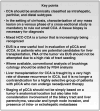Classification, diagnosis, and management of cholangiocarcinoma
- PMID: 22982100
- PMCID: PMC3596004
- DOI: 10.1016/j.cgh.2012.09.009
Classification, diagnosis, and management of cholangiocarcinoma
Abstract
Cholangiocarcinomas (CCAs) are tumors that develop along the biliary tract. Depending on their site of origin, they have different features and require specific treatments. Classification of CCAs into intrahepatic, perihilar, and distal subgroups has helped standardize the registration, treatment, and study of this lethal malignancy. Physicians should remain aware that cirrhosis and viral hepatitis B and C are predisposing conditions for intrahepatic CCA. Treatment options under development include locoregional therapies and a chemotherapy regimen of gemcitabine and cisplatin. It is a challenge to diagnose perihilar CCA, but an advanced cytologic technique of fluorescence in situ hybridization for polysomy can aid in diagnosis. It is important to increase our understanding of the use of biliary stents and liver transplantation in the management of perihilar CCA, as well as to distinguish distal CCAs from pancreatic cancer, because of different outcomes from surgery. We review advances in the classification, diagnosis, and staging of CCA, along with treatment options.
Copyright © 2013 AGA Institute. Published by Elsevier Inc. All rights reserved.
Conflict of interest statement
Figures






References
-
- Everhart JE, Ruhl CE. Burden of digestive diseases in the United States part III: liver, biliary tract, and pancreas. Gastroenterology. 2009;136:1134–1144. - PubMed
-
- Khan SA, Emadossadaty S, Ladep NG, et al. Rising trends in cholangiocarcinoma: is the lCD classification system misleading us? J Hepatol. 2012;56:848–854. - PubMed
-
- Kipp BR, Voss JS, Kerr SE, et al. Isocitrate dehydrogenase 1 and 2 mutations in cholangiocarcinoma. Hum Pathol. 2012;43:1552–1558. - PubMed
Publication types
MeSH terms
Substances
Grants and funding
LinkOut - more resources
Full Text Sources
Other Literature Sources

